Low Energy Renovation of Social Housing: Recommendations on Monitoring and Renewable Energies Use
Abstract
1. Introduction
- Propose a monitoring plan to study the pre-renovation conditions in terms of hygrothermal conditions;
- Propose a monitoring and a survey plan to study the effectiveness of the renovation works in terms of thermal comfort and energy consumption;
- Propose renewable energies customized for the social housing specificities.
2. Methodology
2.1. Studied Neighborhood
2.2. Monitoring Campaign
2.3. Social Survey
- Question 1: aims to characterize the neighborhood demographically, in order to get a detailed understanding of households.
- Questions 2 to 10: this section aims to assess the condition of the dwellings concerning the occurrence of construction anomalies, as well as the satisfaction of residents with their home and their perception of comfort in the heating and cooling seasons.
- Question 11: its objective is to define a typical daily time schedule for the occupation of the dwellings.
- Questions 12 to 19: these questions arise as part of the hygrothermal study of the dwellings, since they are meant to characterize the occupants’ habits regarding ventilation, heating, and cooling of the dwellings.
- Questions 20 to 22: finally, and based on energy poverty concerns in a social housing context, these questions try to assess the lack of means to afford energy bills and the consequences of it.
2.4. Dynamic Simulations
3. Results
3.1. Monitoring Campaign
3.1.1. Thermal Comfort Analysis
3.1.2. Analysis of Occupants Influence
3.2. Social Survey
4. Discussion of Post-Renovation Monitoring and Use of Renewable Energies
4.1. Simulations
4.2. Free Float Pre- and Post-Renovation Analysis
4.3. Selection of the Dwellings to Be Monitored
4.3.1. Preliminary Analyses
4.3.2. Influence of the Orientation
4.3.3. Vertical Location in the Building
4.3.4. The Most and the Least Critical Dwellings
4.4. Pre and Post-Renovation Analysis Considering Heating Systems and Renewable Energies
5. Recommendation for Post-Renovation Monitoring and Renewable Energies
5.1. Recommendations on Monitoring
5.1.1. Monitoring System Architecture
5.1.2. Selected Dwellings, Sensor Placement, and Operation
5.2. Recommendations for Renewable Energy in Social Housing
6. Conclusions
Author Contributions
Funding
Institutional Review Board Statement
Informed Consent Statement
Data Availability Statement
Acknowledgments
Conflicts of Interest
References
- Rolim, C.; Gomes, R. Citizen Engagement in Energy Efficiency Retrofit of Public Housing Buildings: A Lisbon Case Study; Springer: Singapore, 2020; pp. 421–431. [Google Scholar]
- Corgnati, S.P.; Cotana, F.; D’Oca, S.; Pisello, A.L.; Rosso, F. A Cost-Effective Human-Based Energy-Retrofitting Approach. In Cost-Effective Energy Efficient Building Retrofitting; Pacheco-Torgal, F., Granqvist, C.-G., Jelle, B.P., Vanoli, G.P., Bianco, N., Kurnitski, J., Eds.; Woodhead Publishing: Cambridge, UK, 2017; Chapter 8; pp. 219–295. [Google Scholar] [CrossRef]
- 2010/31/EU. Directive 2010/31/EU of the European Parliament and of the Council of 19 May 2010 on the Energy Performance of Buildings 2010; European Union: Brussels, Belgium, 2010. [Google Scholar]
- Gunay, H.B.; Bursill, J.; Huchuk, B.; O’Brien, W.; Beausoleil-Morrison, I. Shortest-prediction-horizon model-based predictive control for individual offices. Build. Environ. 2014, 82, 408–419. [Google Scholar] [CrossRef]
- Garrido-Soriano, N.; Rosas-Casals, M.; Ivancic, A.; Álvarez-Del Castillo, M.D. Potential energy savings and economic impact of residential buildings under national and regional efficiency scenarios. A Catalan case study. Energy Build. 2012, 49, 119–125. [Google Scholar] [CrossRef]
- 2018/844/EU. Directive 2018/844/EU Amending Directive 2010/31/EU on the Energy Performance of Buildings and Directive 2012/27/EU on Energy Efficiency; European Union: Brussels, Belgium, 2018. [Google Scholar]
- SWD/2016/0414. Proposal for a Directive of the European Parliament and of the Council Amending Directive 2010/31/EU on the Energy Performance of Buildings; European Commission: Brussels, Belgium, 2016. [Google Scholar]
- Ramos, N.M.M.; Almeida, R.M.S.F.; Simões, M.L.; Delgado, J.M.P.Q.; Pereira, P.F.; Curado, A.; Soares, S.; Fraga, S. Indoor hygrothermal conditions and quality of life in social housing: A comparison between two neighbourhoods. Sustain. Cities Soc. 2018, 38, 80–90. [Google Scholar] [CrossRef]
- Barbosa, J.T.L. Co-Benefícios da Reabilitação Energética do Parque Residencial Construído; Escola de Engenharia: São Carlos, Brazil, 2016. [Google Scholar]
- Pittini, A. The State of Housing in the EU 2019; House Europe: Brussels, Belgium, 2019. [Google Scholar]
- Pittini, A.; Koessl, G.; Dijol, J.; Lakatos, E.; Ghekiere, L. The State of Housing in the EU 2017; House Europe: Brussels, Belgium, 2017. [Google Scholar]
- da Costa Borges, C. Habitação Social no Concelho do Porto Uma Fase de Vida ou Uma Solução Para a Vida? [Edição do Autor]; Faculdade Engenharia, Universidade do Porto: Porto, Portugal, 2017. [Google Scholar]
- Antunes, G. Política de Habitação Social em Portugal: De 1974 à Actualidade. Forum Sociol. 2019, 34, 7–17. [Google Scholar] [CrossRef]
- Instituto Nacional de Estatisticas. Fogos de Habitação Social (N.º) Por Localização Geográfica (NUTS—2013) e Destino dos Fogos; Instituto Nacional de Estatisticas: Lisbon, Portugal, 2015. [Google Scholar]
- EUROSTAT. Can You Afford to Heat Your Home? Available online: https://ec.europa.eu/eurostat/web/products-eurostat-news/-/DDN-20200106-1?inheritRedirect=true&redirect=%2Feurostat%2F (accessed on 8 October 2020).
- Horta, A.; Gouveia, J.P.; Schmidt, L.; Sousa, J.C.; Palma, P.; Simões, S. Energy poverty in Portugal: Combining vulnerability mapping with household interviews. Energy Build. 2019, 203, 109423. [Google Scholar] [CrossRef]
- Gomes, R.; Ferreira, A.; Azevedo, L.; Costa Neto, R.; Aelenei, L.; Silva, C. Retrofit measures evaluation considering thermal comfort using building energy simulation: Two Lisbon households. Adv. Build. Energy Res. 2018. [Google Scholar] [CrossRef]
- Soares, S.; Brochado, S.; Ramos, N.; Duarte, R.; Norton, P.; Delgado, J.; Fraga, S. Health and living conditions in social housing: Comparison between rehabilitated and non-rehabilitated neighbourhoods. J. Public Health 2016, 24, 535–544. [Google Scholar] [CrossRef]
- Cardoso, S. The Energy/Comfort Nexus: Towards Adaptive Approaches in Europe; Social Green-Interreg Europe: Lisboa, Portugal, 2019. [Google Scholar]
- Belmonte, J.F.; Barbosa, R.; Almeida, M.G. CO2 concentrations in a multifamily building in Porto, Portugal: Occupants’ exposure and differential performance of mechanical ventilation control strategies. J. Build. Eng. 2019, 23, 114–126. [Google Scholar] [CrossRef]
- Escandón, R.; Suárez, R.; Sendra, J.J. On the assessment of the energy performance and environmental behaviour of social housing stock for the adjustment between simulated and measured data: The case of mild winters in the Mediterranean climate of southern Europe. Energy Build. 2017, 152, 418–433. [Google Scholar] [CrossRef]
- Abrantes, N.; Alves, F.; Abrantes, V. The City of Porto and the Public Housing: Learning With Design Practice. Int. J. Hous. Sci. Its Appl. 2015, 39, 65–78. [Google Scholar]
- Santamouris, M.; Alevizos, S.M.; Aslanoglou, L.; Mantzios, D.; Milonas, P.; Sarelli, I.; Karatasou, S.; Cartalis, K.; Paravantis, J.A. Freezing the poor—Indoor environmental quality in low and very low income households during the winter period in Athens. Energy Build. 2014, 70, 61–70. [Google Scholar] [CrossRef]
- Diaz Lozano Patino, E.; Siegel, J.A. Indoor environmental quality in social housing: A literature review. Build. Environ. 2018, 131, 231–241. [Google Scholar] [CrossRef]
- Lucchi, E.; Delera, A.C. Enhancing the Historic Public Social Housing through a User-Centered Design-Driven Approach. Buildings 2020, 10, 159. [Google Scholar] [CrossRef]
- Leite, V. Architecture of Participation; University of Porto: Porto, Portugal, 2010. (In Portuguese) [Google Scholar]
- ISO-7726. Ergonomics of the Thermal Environment—Instruments for Measuring Physical Quantities; International Organization for Standardization: Geneva, Switzerland, 1998. [Google Scholar]
- Hnat, T.W.; Srinivasan, V.; Lu, J.; Sookoor, T.I.; Dawson, R.; Stankovic, J.; Whitehouse, K. The hitchhiker’s guide to successful residential sensing deployments. In Proceedings of the 9th ACM Conference on Embedded Networked Sensor Systems, Seattle, WA, USA, 1–4 November 2011; pp. 232–245. [Google Scholar]
- Pereira, P.F.; Ramos, N.M.M. The Influence of Sensor Placement in the Study of Occupant Behavior in a Residential Building. In Proceedings of the 2018 International Conference on Smart Energy Systems and Technologies (SEST), Seville, Spain, 10–12 September 2018; pp. 1–6. [Google Scholar]
- EN-16798-1. Energy Performance of Buildings Ventilation of Buildings EN 16798-1: 2019 Part 1 Indoor Environmental Input Parameters for Design and Assessment of Energy Performance of Buildings Addressing Indoor Air Quality, Thermal Environment, Lighting and Acoustics-Module M1-6; CEN: Brussels, Belgium, 2019; 79p. [Google Scholar]
- ISO-7730. Ergonomics of the Thermal Environment Analytical Determination and Interpretation of Thermal Comfort Using Calculation of the PMV and PPD Indices and Local Thermal Comfort Criteria ISO 7730: 2005, 3rd ed.; ISO: Geneva, Switzerland, 2005; 60p. [Google Scholar]
- Decreto-Lei n.º 118/2013, D.d.R., 1.ª série—N.º 159. Regulamento de Desempenho Energético dos Edifícios de Habitação (REH); Diário da República Eletrónico: Lisboa, Portugal, 2013.
- EN-15251. Indoor Environmental Input Parameters for Design and Assessment of Energy Performance of Buildings Addressing Indoor Air Quality, Thermal Environment, Lighting and Acoustics; CEN: Brussels, Belgium, 2007. [Google Scholar]
- Ulukavak Harputlugil, G.; Harputlugil, T.; Pedergnana, M.; Sarıoğlu, E. A novel approach for renovation of current social housing stock based on energy consumption in Turkey: Significance of occupant behaviour. Archit. Sci. Rev. 2019. [Google Scholar] [CrossRef]
- Pereira, P.F.; Ramos, N.M.M.; Ferreira, A. Room-scale analysis of spatial and human factors affecting indoor environmental quality in Porto residential flats. Build. Environ. 2020, 186, 107376. [Google Scholar] [CrossRef]
- Eurostat. Electricity Prices by Type of User. Available online: https://ec.europa.eu/eurostat/databrowser/view/ten00117/default/table?lang=en (accessed on 18 November 2020).

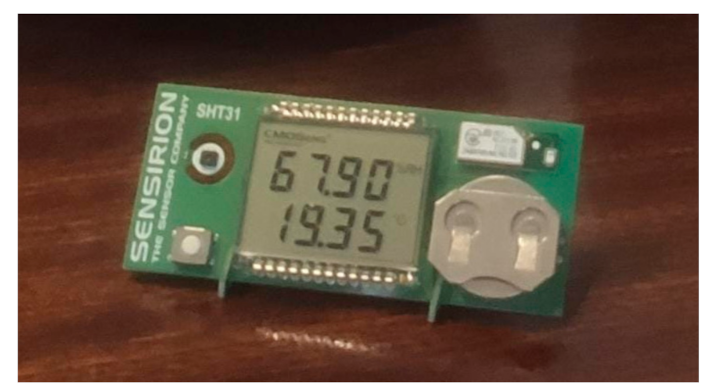

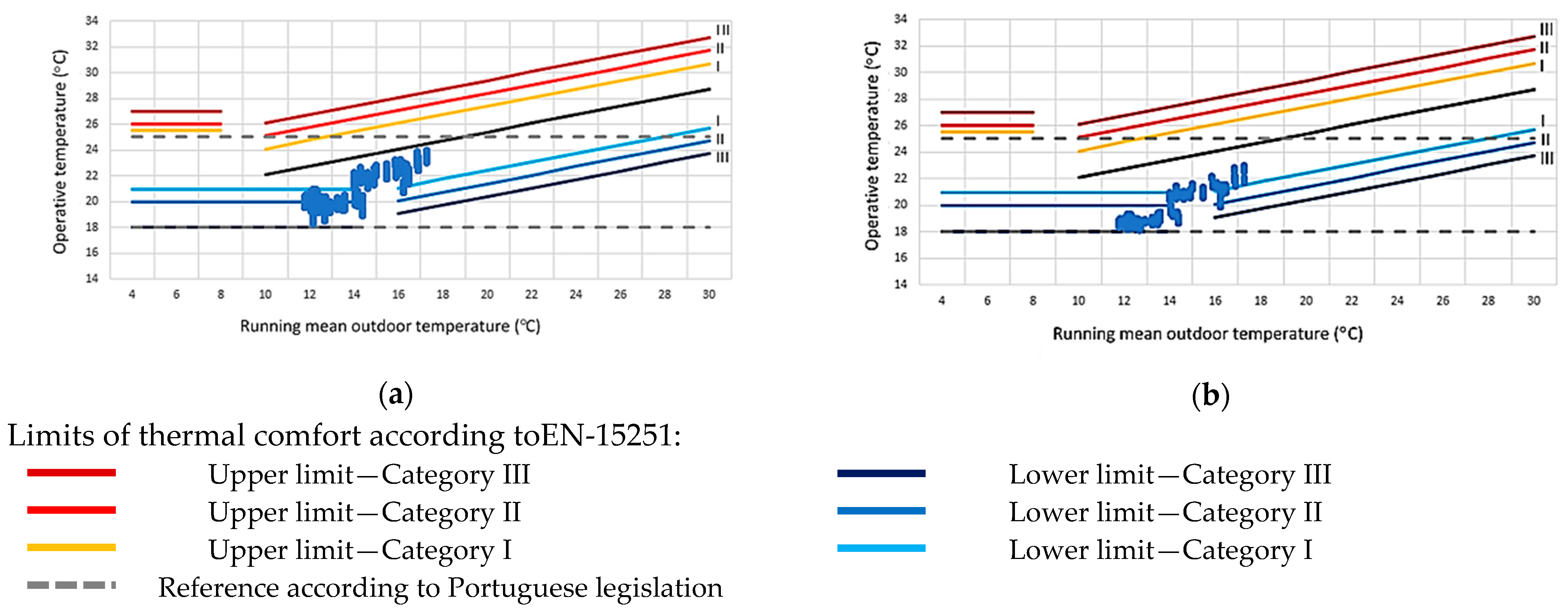
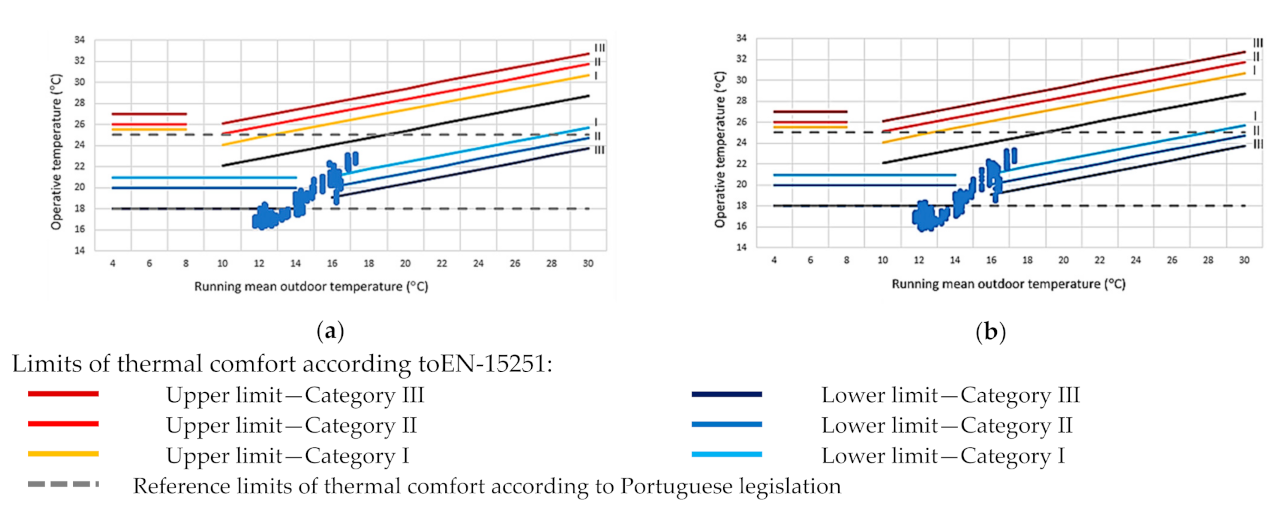
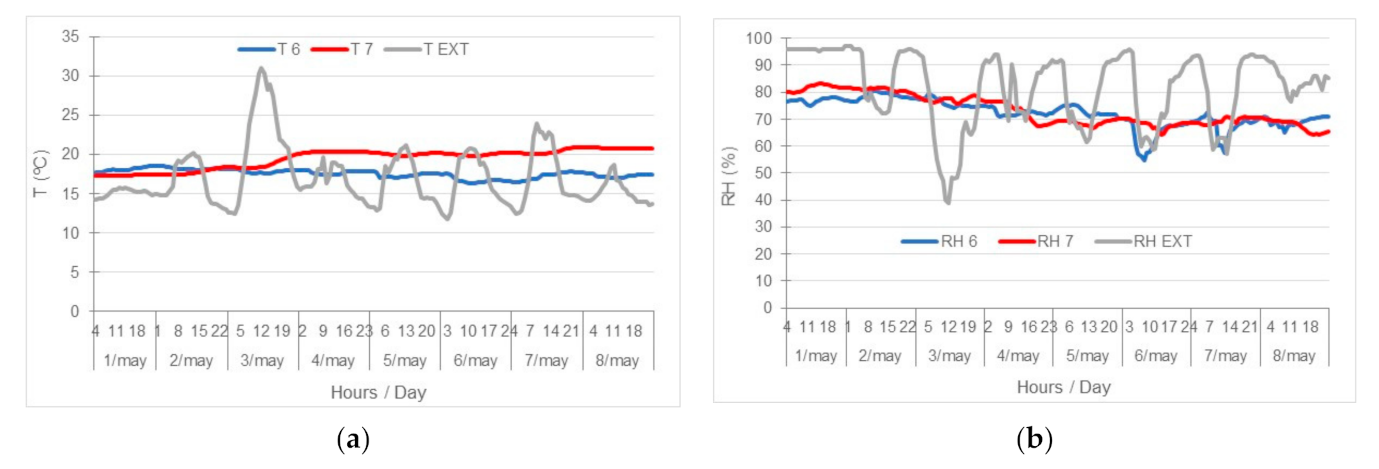
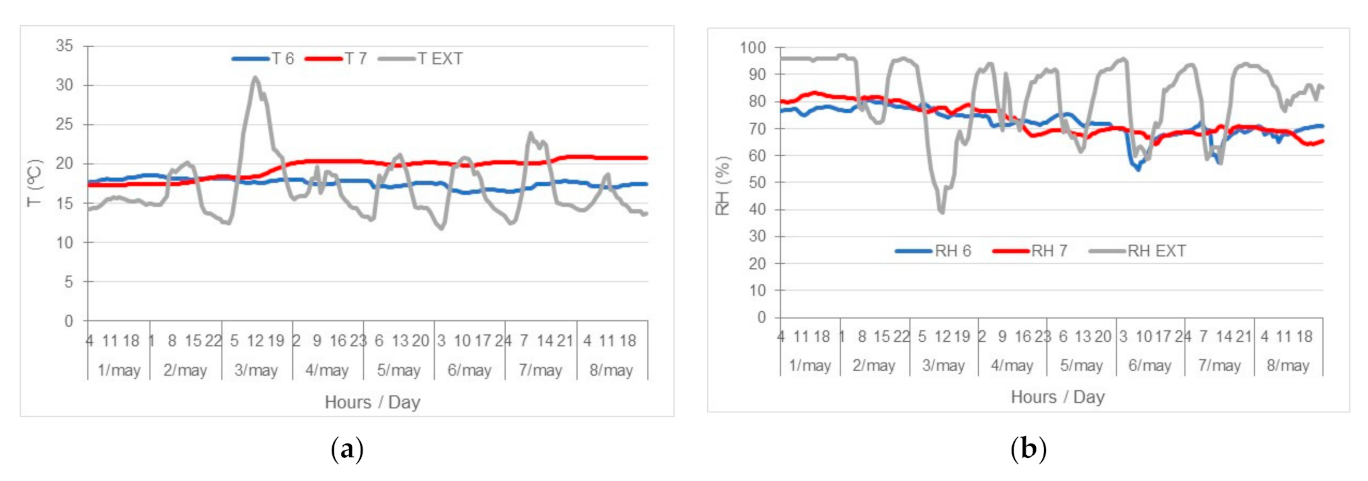
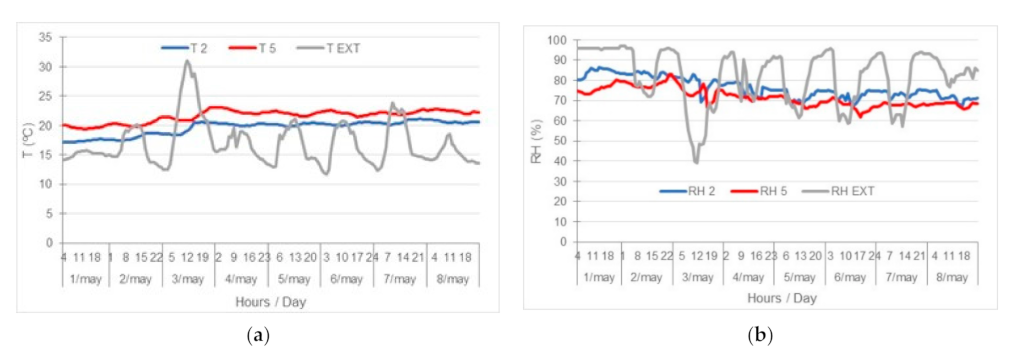
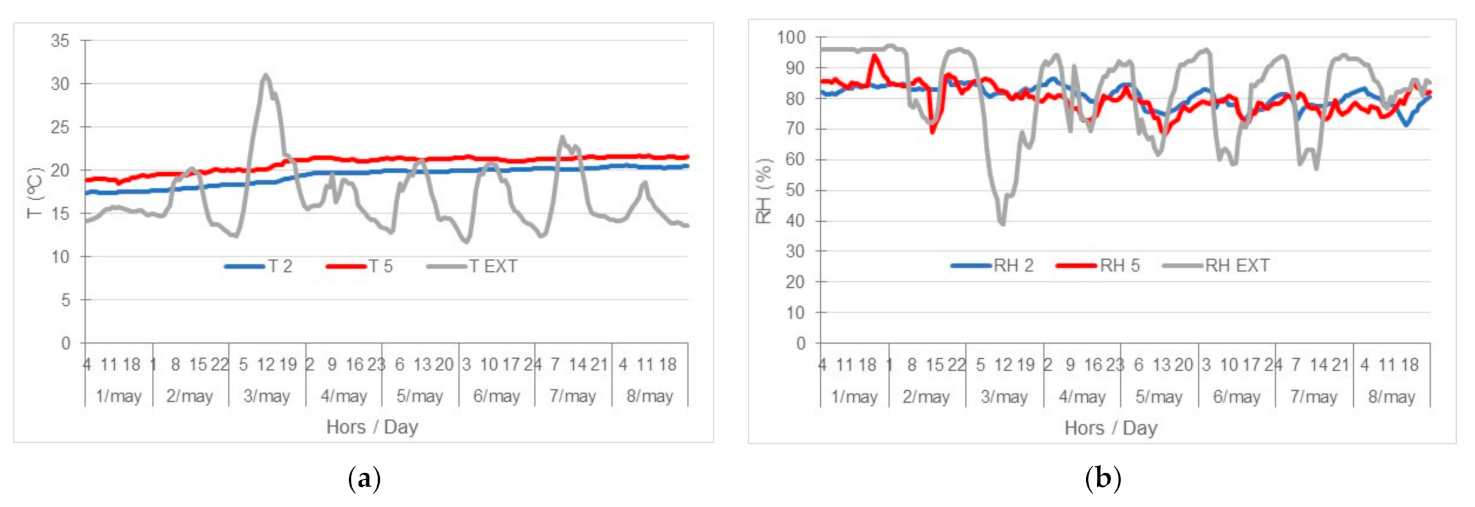
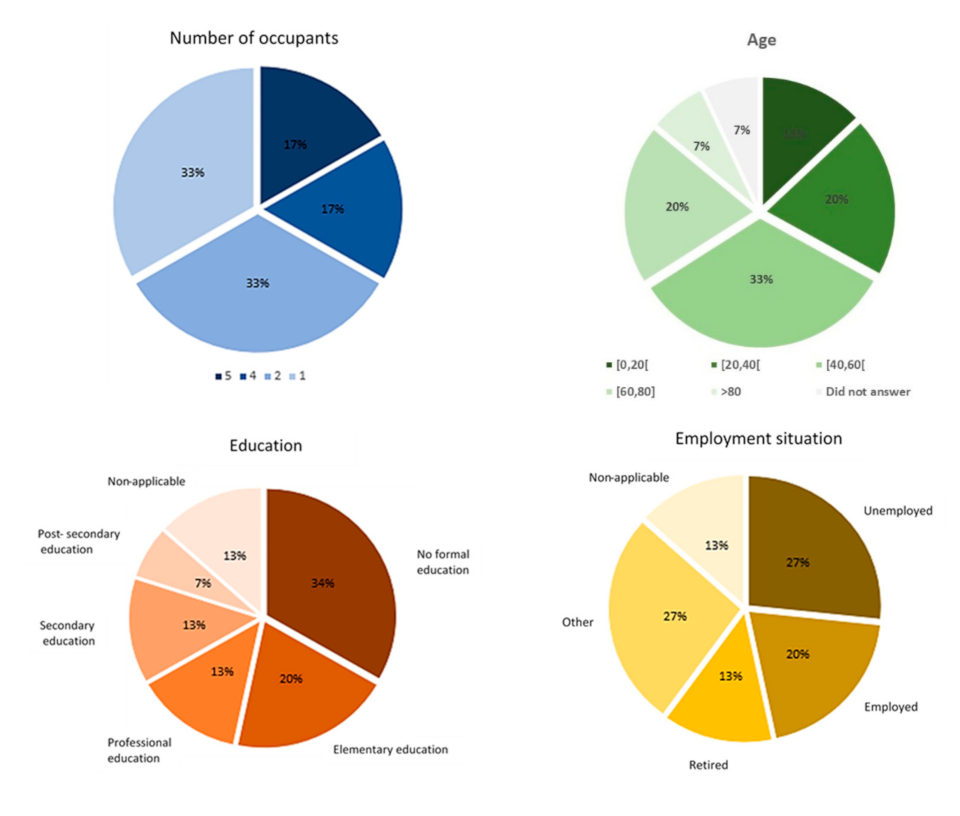
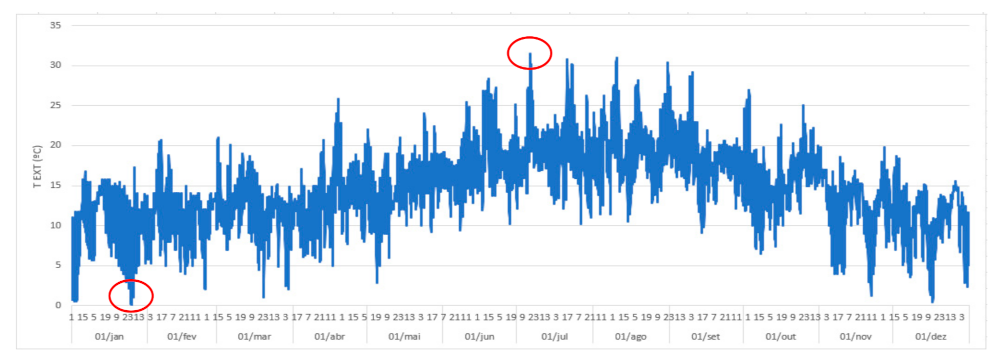
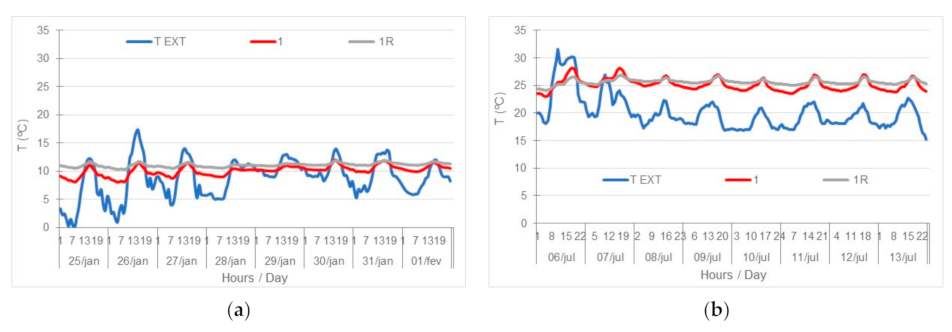
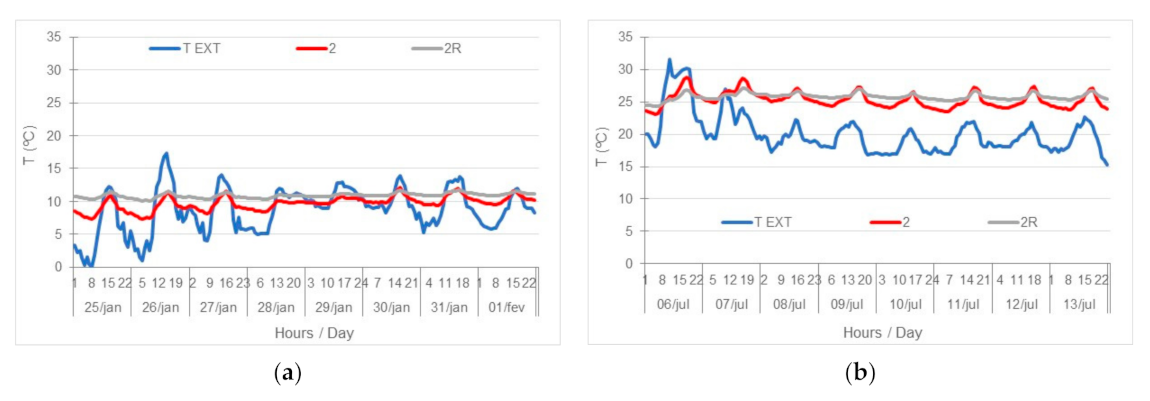

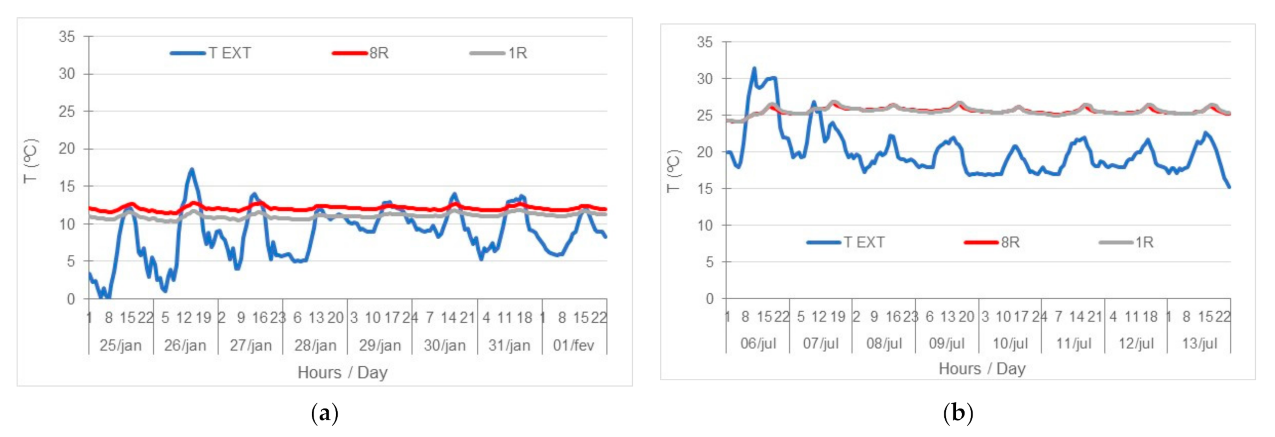
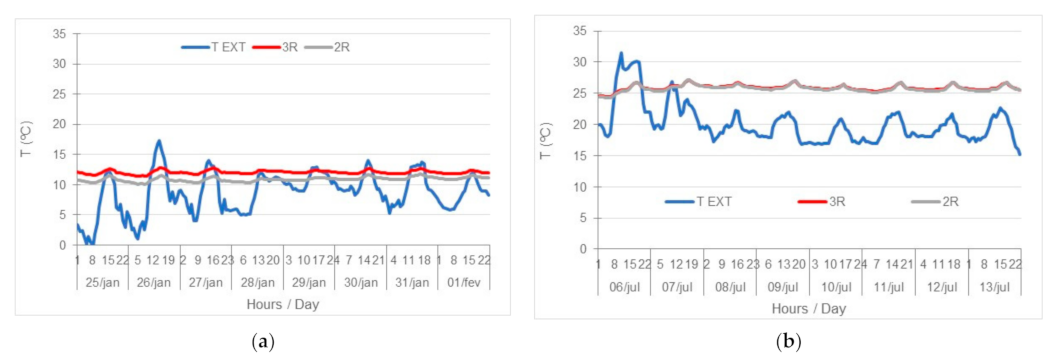
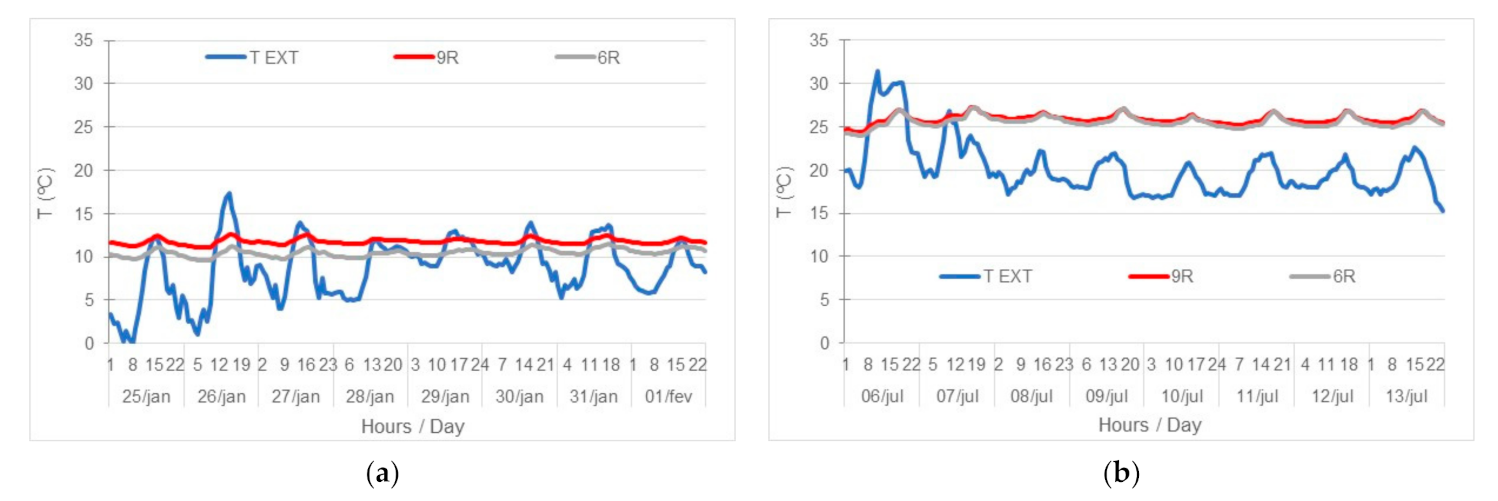
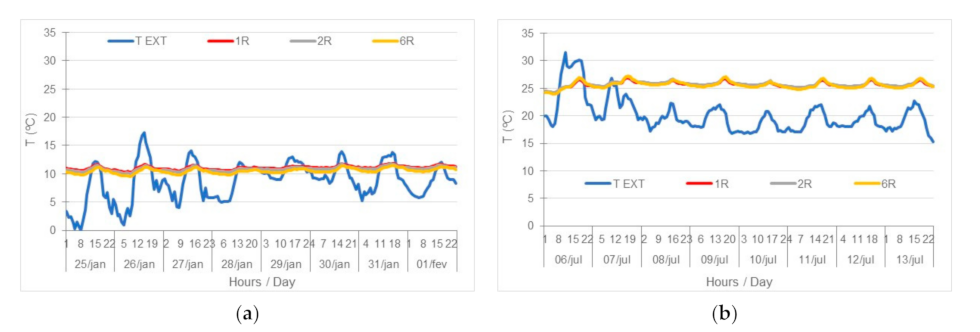
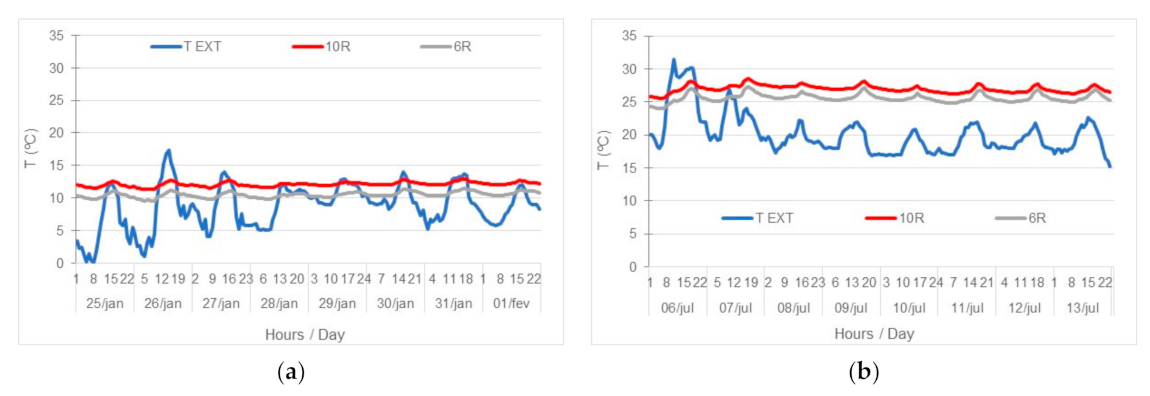
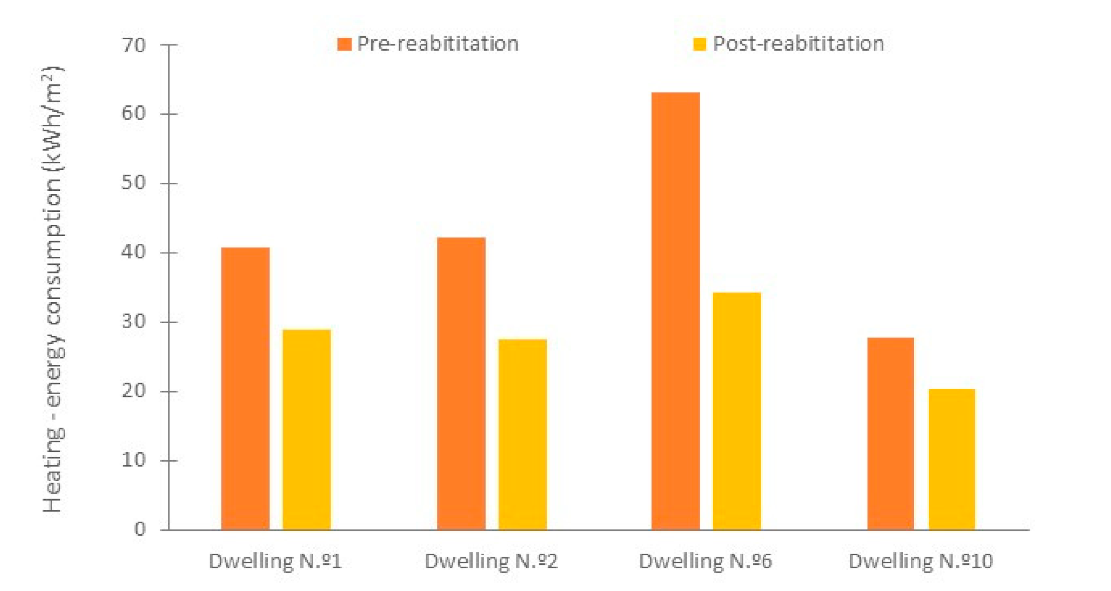
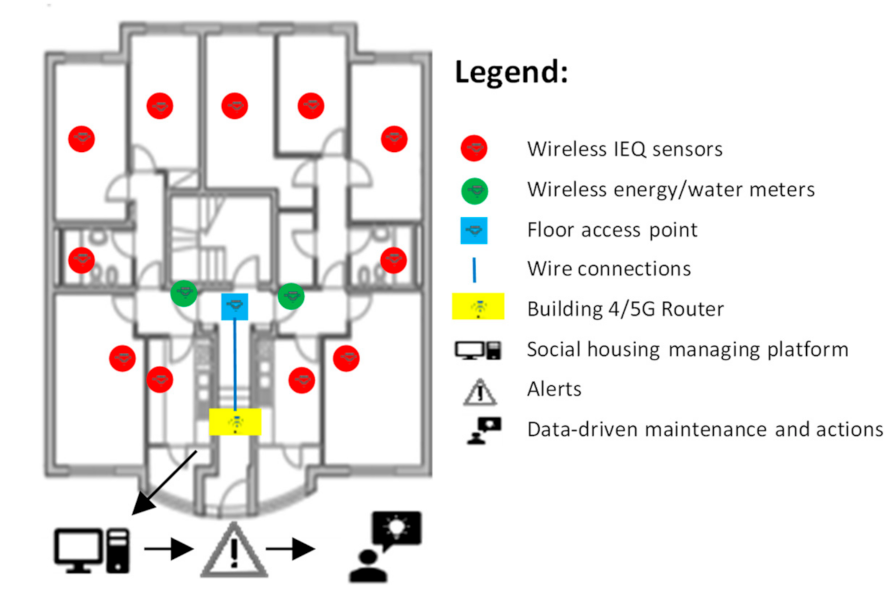
| Construction Element | Thermal Transmittance Coefficient, U-Value (W/(m2·°C)) | Construction Solution |
|---|---|---|
| External walls (0.40 m) | 0.96 | Double hollow brick masonry wall, 11 and 15 cm thick, plastered on the inside and coated with light coloured industrial cementitious mortar on the outside. |
| Walls that separate apartments from the staircase (0.24 m) | 1.16 | Simple hollow brick masonry wall coated on the outer face with light colored industrial cementitious mortar and on the inner face with stucco or ceramic tiles. |
| Pitched roof | Uasc = 1.90 Udesc = 1.44 | The second floor ceiling slab is a concrete slab of prestressed joists and ceramic blocks with no thermal insulation. The attic is poorly ventilated. The roof slopes are covered with fibre cement sheets. |
| Ground floor slab (with sanitary air space underneath) | 1.18 | Concrete slab of prestressed joists and ceramic blocks coated with wood parquet or ceramic tiles. |
| Windows | 3.10 | Aluminium frames with clear double-glazing and an outer plastic roller blind of a light colour. |
| Renovation Action | Construction Solution | U-Value (W/(m2·°C)) |
|---|---|---|
| Application of thermal insulation on the external walls after cracking repair | ETICS | 0.390 |
| Replacement of fibre cement sheets by sandwich panels and application of thermal insulation on the ceiling slab | Sandwich panels as roof covering. Application of 0.10 m of mineral wool on the second floor ceiling slab. | Uasc = 0.330 Udesc = 0.313 |
| Dwelling Number | Floor | Glazing Orientation | Occupancy |
|---|---|---|---|
| 1 | Ground-floor | E and W | Occupied |
| 2 | First floor | E and W | Occupied |
| 3 | First floor | E and W | Occupied |
| 4 | First floor | E and W | Occupied |
| 5 | First floor | E and W | Occupied |
| 6 | Second floor | E and W | Occupied |
| 7 | Second floor | E and W | Vacant |
| Data | Lighting and Room Electricity (kWh) | DHW (Gas) (kWh) | PV Generation (kWh) | Pre-Renovation Simulation | Post-Renovation Simulation |
|---|---|---|---|---|---|
| Heating (kWh) | Heating (kWh) | ||||
| Jan | 2656.7 | 1900.5 | 2364.0 | 13,772.0 | 9625.2 |
| Feb | 2406.5 | 1733.9 | 2957.0 | 9631.0 | 6696.5 |
| Mar | 2674.6 | 1945.3 | 4499.9 | 7091.0 | 4926.0 |
| Apr | 2573.3 | 1844.9 | 5198.6 | 2991.4 | 2164.7 |
| May | 2656.7 | 1900.5 | 5452.0 | 1190.1 | 775.3 |
| Jun | 2591.2 | 1889.7 | 5499.4 | 21.1 | 17.2 |
| Jul | 2656.7 | 1900.5 | 5479.1 | 0.0 | 0.0 |
| Aug | 2665.7 | 1922.9 | 5474.0 | 0.2 | 0.0 |
| Sept | 2582.3 | 1867.3 | 4481.3 | 51.9 | 3.9 |
| Oct | 2656.7 | 1900.5 | 3717.9 | 2340.0 | 1294.8 |
| Nov | 2582.3 | 1867.3 | 2094.0 | 8155.3 | 5371.7 |
| Dec | 2665.7 | 1922.9 | 2129.0 | 11,785.4 | 8195.2 |
| TOTAL | 31,368.5 | 22,596.1 | 49,346.2 | 57,029.4 | 39,070.5 |
| Data | Surplus kWh | Purchased kWh |
|---|---|---|
| Jan | 1686.6 | 11,604.5 |
| Feb | 2138.7 | 8284.8 |
| Mar | 3405.2 | 6505.9 |
| Apr | 4189.6 | 3728.9 |
| May | 4393.0 | 2373.1 |
| Jun | 4452.8 | 1561.8 |
| Jul | 4514.1 | 1691.7 |
| Aug | 4562.8 | 1754.5 |
| Sept | 3755.8 | 1860.7 |
| Oct | 3030.7 | 3264.3 |
| Nov | 1484.6 | 7344.6 |
| Dec | 1511.3 | 10,243.1 |
| TOTAL | 39,125.2 | 60,218.0 |
Publisher’s Note: MDPI stays neutral with regard to jurisdictional claims in published maps and institutional affiliations. |
© 2021 by the authors. Licensee MDPI, Basel, Switzerland. This article is an open access article distributed under the terms and conditions of the Creative Commons Attribution (CC BY) license (http://creativecommons.org/licenses/by/4.0/).
Share and Cite
Seabra, B.; Pereira, P.F.; Corvacho, H.; Pires, C.; Ramos, N.M.M. Low Energy Renovation of Social Housing: Recommendations on Monitoring and Renewable Energies Use. Sustainability 2021, 13, 2718. https://doi.org/10.3390/su13052718
Seabra B, Pereira PF, Corvacho H, Pires C, Ramos NMM. Low Energy Renovation of Social Housing: Recommendations on Monitoring and Renewable Energies Use. Sustainability. 2021; 13(5):2718. https://doi.org/10.3390/su13052718
Chicago/Turabian StyleSeabra, Bianca, Pedro F. Pereira, Helena Corvacho, Carla Pires, and Nuno M. M. Ramos. 2021. "Low Energy Renovation of Social Housing: Recommendations on Monitoring and Renewable Energies Use" Sustainability 13, no. 5: 2718. https://doi.org/10.3390/su13052718
APA StyleSeabra, B., Pereira, P. F., Corvacho, H., Pires, C., & Ramos, N. M. M. (2021). Low Energy Renovation of Social Housing: Recommendations on Monitoring and Renewable Energies Use. Sustainability, 13(5), 2718. https://doi.org/10.3390/su13052718








